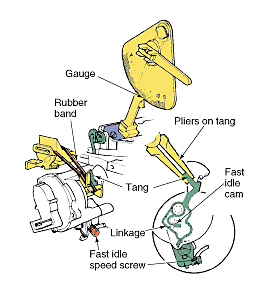Yes it can here is what to inspect on the choke pull-off
A malfunctioning choke can cause a variety of performance problems, from no-start to missing and power loss at cruising speeds. These problems can be caused by the choke being stuck closed, the choke being stuck open, inoperative choke pull-off, or a malfunctioning bimetal choke coil.
A visual inspection may identify the trouble spot quickly. Remove the air cleaner, making sure to label each vacuum hose as it is disconnected. If the engine is cold, the choke should be closed. Watch the choke plate as an assistant cranks the engine.
Check for broken or leaking vacuum hoses.
Check for a cracked housing.
and testing of choke pull-off
If the choke plate is not opening when the engine starts, check for a vacuum leak in the choke qualifying mechanism. If a diaphragm vacuum break is used, look for a cracked vacuum hose or loose hose connections.
To check the diaphragm:
Remove the vacuum hose, and install a vacuum pump.
Apply vacuum to the pump diaphragm.
If the diaphragm does not hold vacuum or if the vacuum leaks down faster than the manufacturer specifies, the vacuum break should be replaced.

Adjusting the fast idle cam.
If the carburetor has a secondary vacuum break:
Test the thermal vacuum valve or choke vacuum thermal switch.
Consult the manufacturer's service manual for temperature specifications.
Connect a vacuum pump to the lower port and a vacuum gauge to the upper port.
Apply the specified vacuum and alternately warm and cool the valve or switch. The valve should permit vacuum passage when the valve is warm and block vacuum when the valve is cold. If the engine runs rough immediately after start-up, the choke might not be opening the specified amount.
To check the qualifying dimension: Apply the specified vacuum to the diaphragm using a vacuum pump. Measure the clearance between the upper edge of the choke plate and the air horn wall using a drill bit with a diameter equal to the specified dimension.
To adjust the dimension, bend the choke linkage with a pair of pliers. Operation of the heating element is checked with a digital volt-ohmmeter.
Refer to the manufacturer's service manual for procedures and specifications.
Before making any adjustments on the choke, move its linkage by hand to be certain there is no binding or sticking in the linkage, shaft, or choke plate.
Use an approved carburetor cleaner to remove any gum deposits that interfere with its operation.
If the choke housing permits adjustment of the choke setting, the choke can be adjusted to enrich or lean the air/fuel mixture
you may also have to ajust Choke Thermostat
Friday, October 24th, 2008 AT 10:59 AM




